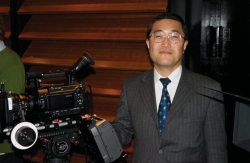
The centrepiece of Sony’s offering at NAB will be its new SRMemory, an expansion of its SR format and a move beyond HD, writes David Fox. The HDCAM-SR format has been Sony’s high-end tape system, but it will soon be moving mainstream, for broadcast multicamera recording and as an option on its mid-priced PMWF3 Super35mm camcorder. It will also be going tapeless, using solid-state cards with capacities of up to 1TB.
This is part of Sony’s push to cater for not just HD, but higher resolution capture, including 4K and above. Of course, “resolution alone does not make better pictures. There are other imaging parameters that we need to consider, such as higher dynamic range, wider colour space, multiple view points (such as 3D), and higher frame rates,” said Yasuhiko Mikami, its senior manager for Product Planning.
“By improving the technology and our products in these five directions, we can start addressing new applications that exist outside of the traditional broadcast business, such as 4K cinema and ODS (other digital stuff), UDTV, 3D, and HDR.”
The new SRMemory will allow realtime recording and playback, file-based post production, and offer scalable compression levels for different types of application (one of the first of which he believes will be for the Olympics in 2012). It uses the MPEG-4 Simple Studio Profile, which covers everything from standard definition to 4K x 2K 4:4:4 at 10- or 12-bit 50/60p.
“Memory is a very good choice for high-capacity, high-speed recording, but there is still the problem of archiving, so we have to come up with a good way of integrating memory and tape for archive,” he added.
To enable SR file-based operation, Sony is providing the native SR compressed file and wrapping it in MXF. “SR is based on MPEG-4 SStP. A completely open codec,” he explained. For high-end post work, this can be encapsulated in DPX files. However, this would be unnecessary for most broadcast work, so it is also adding a new level: SR Lite, which will record at 220Mbps. The other levels are 440Mbps SQ, for acquisition and post, and 880Mbps for 1080 50/60p and visual effects.
On file
SR Lite means “you can shrink the file size to half with minimum sacrifice in image quality. We firmly believe it is important to keep your camera original material at the highest possible quality. However when you’re finished with grading, compositing, editing, you can shrink the file to make it pass through the broadcast food chain more easily. We also plan to create SR Lite files from regular HDCAM tapes, so that images acquired on your ten-year-old F900 will still fit into the modern post production environment,” said Mikami.
Sony has been working with the EBU to offer a production codec for HD production, and tests have shown that “SR Lite seems very promising, even after multiple generations.”
The simplest way to go filebased is to upgrade its existing SRW-5800 HDCAM/HDCAMSR tape deck. The new 5800/2 will offer MXF file transfer, 4:2:2 and 4:4:4 double-speed recording and playback, 3D recording and playback, 2K in realtime (2048×1556 / 2048×1080), and 12 channels of 96k/24bit audio.
Avid’s Media Composer, Apple Final Cut Pro and FilmLight will all be supporting SR, and Mikami, who was speaking to a dealer meeting in London, showed plans for an SR Data Transfer Unit that will allow fast ingest of cards or tapes to servers or NLEs. It will support NFS and CIFS disk formats to mount a shared directory or folder on NLEs or servers, and can ingest using GbE or, optionally, 10GbE. It will also clone SRMemory to tape at two times normal speed and will be controllable via a web browser.
On deck
There will also be a new SRMemory Deck, which can be used as a multi-channel recorder for studio or outside broadcast. It is smaller than a normal VTR (4RU), but can handle four channels of I/O, including 3D or 4K, recording at 220Mbps, 440Mbps, or 880Mbps, or uncompressed DPX, with 16 channels of 24-bit PCM audio. Each HD video channel is 3G SDI dual-link capable — 1080/60P 3D or Key + Fill. It can also have up to 8TB of internal fixed memory, giving it a maximum capacity of 12TB (100 hours of SR Lite). It can also copy material to SR tape for backup.
“The Memory Deck is very flexible in terms of I/O. It can combine four cameras onto a single card and use another card as backup, or one 2D or 3D camera onto four cards, if required,” he explained. Theoretically it could have 12 inputs and record 12 channels onto a single card. SR memory has a guaranteed transfer rate of 5Gbps, more than fast enough to enable multichannel HD and high framerate recording, and cards will be offered in various capacities, from 256GB to 1TB.
Sony chose 5Gbps as its design goal because if you record 4K 60p, full RGB, 10-bit material, the uncompressed data rate is about 20Gbps. “Then apply 4:1 good quality compression, like SR, and that gives 5Gbps.”
An SxS card has a maximum transfer rate of 800Mbps, but this can fall to 200Mbps due to fragmenting and poor memory management. However, in SRMemory “a very clever memory chip controller mechanism is built in, so you will never skip a frame during recording or playback.” It ensures that no single memory sector gets over used (making it more likely to fail), and has “incredible error correction.”
On camera
For acquisition there will be a portable SRMemory recorder capable of 3G and HD-SDI dual link recording, including uncompressed DPX files. When used with an optionally-upgraded PMW-F3 Super 35mm camcorder, it can record 10-bit S-Log RGB files, with look-up tables (which are baked in to the MPEG-2 4:2:0 copies recorded to the SxS card, for offline use). “It’s a very self-contained, integrated solution,” said Mikami. However, it does need a dedicated power supply. The unit could be used with any camera with dual-link SDI, but it will only handle variable speed recording on the F3, thanks to a dedicated connection — the F3 won’t do variable frame rates with third-party recorders.
The high-end SRW-9000PL camcorder started shipping as a tape-based unit, but there will be a card-based version by the end of the year, and all existing models will be upgradeable (with the card recorder replacing the tape drive). Users could also just add an external SRMemory unit in addition to recording to tape.
www.pro.sony.eu






